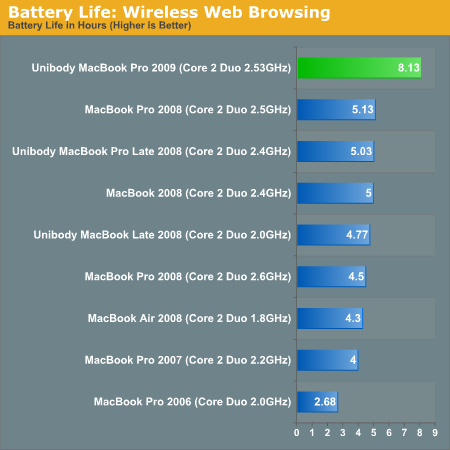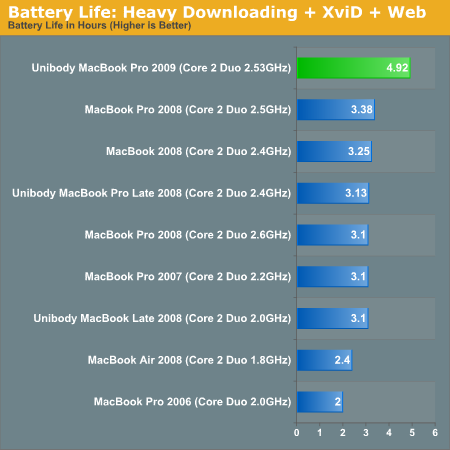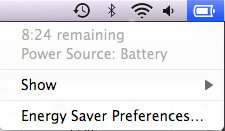Apple's 2009 MacBook Pro: Battery Life to Die For
by Anand Lal Shimpi on June 12, 2009 12:00 AM EST- Posted in
- Mac
The Best Battery Life I’ve Ever Seen
To find out how well the new lithium polymer battery does I ran my usual suite of Mac battery life tests. First up was my wireless web browsing test:
The wireless web browsing test uses the 802.11n connection to browse a series of 20 web pages varying in size, spending 20 seconds on each page (I timed how long it takes me to read a page on Digg and came up with 36 seconds; I standardized on 20 seconds for the test to make things a little more stressful). The test continues to loop all while playing MP3s in iTunes.
This is an extremely light test as none of the web pages have any flash ads, but it’s a valid test of very light wireless usage.

Eight, freakin, hours. I couldn't believe it. In my lightest test, the new 15-inch MacBook Pro lasted eight hours and eight minutes. That's with the screen at half brightness (completely usable) and no funny optimizations. The notebook is just playing music and surfing through a lot of my old reviews. There's no way this could be right. Maybe my test was too light?
I threw together another test just to make sure. The key flaw in my initial wireless web browsing test is that it none of web pages have any Flash on them. While constantly loading web pages will ensure the CPU can't go into deep sleep, Flash on the pages would make sure that the CPU utilization remains higher at all times. The next test I put together was this:
I strung together 8 reviews on AnandTech and put them each on a single page, images and all. I then scoured the web for big, animated Flash ads and added anywhere from 1 - 4 ads per page; all Flash. Each page is designed to forward to the next after 10 seconds and the loop continues indefinitely. On each machine I opened three Safari windows and pointed them at the first page in the sequence. In the background, once more, I had iTunes playing MP3s.
I found that CPU utilization varied from 5 - 35% during this test, which is about what I saw when I was actually surfing the web myself. The addition of Flash should make it more stressful, but it's still a fairly light usage test. My original web browsing test got us 8 hours, so what about this new one?
| MacBook Pro 2009 | MacBook Pro Late 2008 | |
| Wireless Web Browsing w/ Flash | 6.48 hours | 3.28 hours |
Six and a half hours, out of a 5.5 lbs notebook. For comparison, the older MacBook Pro could only manage 3 hours and 17 minutes in the same test. The new notebook lasted almost twice as long. Mathematically, this doesn't make sense. There's only a 46% increase in battery capacity, there shouldn’t be a ~100% increase in battery life...ever.
While the original web browsing test was using data from my original unibody MacBook Pro review, this second web test used a brand new MacBook Pro (purchased just weeks before this week's MacBook Pro announcement). The two notebooks had the same amount of memory (4GB), the older MacBook Pro had a slower CPU (2.4GHz vs. 2.53GHz) and a 7200RPM hard drive but the differences shouldn’t account for an extra 54% increase in battery life.
Apple must have done more than just increase battery capacity in the new MacBook Pro. My third test continues to support my findings. This is my heavy workload benchmark.
For this benchmark I'm downloading 10GB worth of files from the net (constant writes to the drive), browsing the web (same test as the first one) and watching the first two episodes of Firefly encoded in a 480p XviD format (Quicktime is set to loop the content until the system dies).
The older MacBook Pro managed 3.25 hours in this test. The new one? Just under 5:

That's a 51% improvement in battery life. It's close enough to the max theoretical 46% improvement for me to think that the significant gains in wireless web browsing are due to improvements in idle power optimizations. It's possible that all of the components in the new MacBook Pro have been optimized for lower voltages at idle.
The battery tests are repeatable however. I saw anywhere from a 50 - 100% improvement in battery life over the old MacBook Pro. Given the increase in battery capacity alone, you should see no less than a 46% increase in battery life. Exactly what is accounting for the expanded life above and beyond that, I'm not sure.
Either way, Apple's 7 hour claim is well within reason. For light workloads, even on WiFi, you can easily expect 6.5 - 8 hours out of the new 15-inch MBP. As I write this article on that very system I'm told that I have nearly 8.5 hours left on my charge. If you do a lot of writing on your notebook, the new MBP is exactly what you'll want; it will easily last you on a cross-country flight if you need to get work done.

I think I've just found my new writer's companion
My heaviest workload delivered just under 5 hours of battery life, a figure that the old MBP could only attain while running my lightest workload. This thing rocks.
I also have to commend Apple for delivering realistic battery life specs on its laptop. While 7 hours definitely involves a light workload, it is more than attainable as I've shown in the tests above.
A quick search shows that even Dell's Studio 15 only offers a battery rating of up to 5.5 hours. It looks like, once again, other notebook makers will have to play catch up to Apple in this department.










113 Comments
View All Comments
RikkiTikkiTavi - Monday, June 15, 2009 - link
Interesting. As I said my expertise on the mater is limited. It would be interesting to know what reasons there are for cylindrical cells.As I see it, they are more inefficient in both space usage and manufacturing. I'll see if I can find something on this.
santala - Saturday, June 13, 2009 - link
Indeed, the older Macbook batteries contain flat rectangular cells, which was plain to see once opened. Therefore the comparison used by Apple currently, which leads you to believe that they used to be cylinderical, is wrong. They have been rectangular on Macbooks before, the material and size simply has changed, not the shape of the cells themselves.PlasmaBomb - Saturday, June 13, 2009 - link
My apologies, you are indeed correct... browsing my pics folder came up with the answer-http://pics.bbzzdd.com/users/PlasmaBomb/PowerBook....">http://pics.bbzzdd.com/users/PlasmaBomb/PowerBook....
Old powerbook = cylinders (NiMH I think).
http://pics.bbzzdd.com/users/PlasmaBomb/Mackbook.j...">http://pics.bbzzdd.com/users/PlasmaBomb/Mackbook.j...
Macbook = flat cells
(feel free to take a copy of the pics)
So they haven't used cylindrical cells for a long time, bad apple for deliberately misleading people :|
Sorry as I said I don't have a macbook to play with :(
The lithium ion battery from my laptop looked pretty much like this -
http://static.howstuffworks.com/gif/lithium-ion-ba...">http://static.howstuffworks.com/gif/lithium-ion-ba...
when I dismantled it (it was dead).
evilspoons - Friday, June 12, 2009 - link
I have a Mid-2007 15" MacBook Pro (Santa Rosa 2.2 GHz) with 3 GB of RAM and a 500 GB hard drive (both upgraded by me from 2 GB - the extra 1 GB was free, otherwise I'd have 4 GB, and the 120 GB hard drive it came with was awful).Most of the time the battery life is just fine - but damn, this new 15" will DOUBLE what mine gets? Wow!
I think the new 15" MBP - in matte - with 4 or 8 GB RAM, a 512 GB SSD (or a 128 GB plus a hard drive, if there somehow was room: I need my iTunes library!), and maybe with the upcoming quad-core laptop CPUs would make just about the perfect computer.
Hopefully this is what the next generation MacBook Pro will look like and it'll be out about the time I start wishing my 2.2 GHz was faster.
jeffbui - Friday, June 12, 2009 - link
Anand, I'm sure you've put in that X25-M. Let us know how much more battery life the notebook gets. Thanks!JarredWalton - Friday, June 12, 2009 - link
My understanding is that the X25 is a high performance part that doesn't dramatically improve battery life. However, it should be better http://www.anandtech.com/storage/showdoc.aspx?i=34...">by about 6%, give or take.PlasmaBomb - Friday, June 12, 2009 - link
Still 6% of 8 hours is a decent amount...about an extra half hour.
cserwin - Friday, June 12, 2009 - link
As a modeler of RC airplanes, I know that LiPO's require extreme caution, especially when charging. Search youtube for "LiPO Fire".Basically, if you charge the batteries too fast, they burn. Could the smaller brick have to do with battery charging rates?
mmntech - Friday, June 12, 2009 - link
I'm an RC pilot as well and IMO, the safety risks with LiPo packs have been greatly exaggerated in recent years. Most laptops and other portable consumer electronics devices these days already use Li-Ion or LiPo as is. All packs do have a serious risk of explosion and fire, but they usually don't spontaneously combust unless they're cheaply made and have internal faults. Remember that RC packs are rated for much higher performance than laptop packs. They're also subject to more stress in the form of vibration and hard impacts. In 99.9% of cases, they're safe in consumer electronics provided they aren't abused.The batteries used for laptops have built in charge circuitry and balancers.
PlasmaBomb - Friday, June 12, 2009 - link
That is what the chip in the battery and charging controller are for.